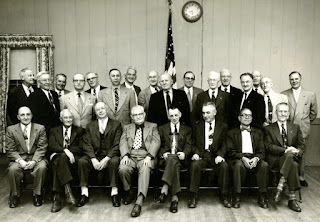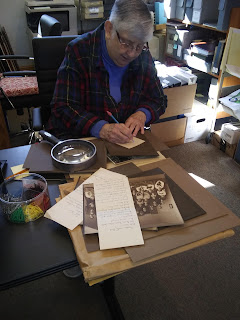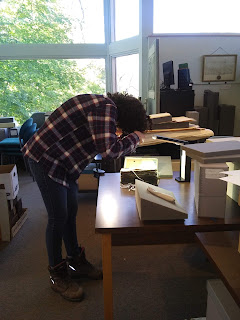This post was written by library volunteer Diane Leone.
Men and women who serve in the military together, particularly during wartime, form a tight bond that often lasts a lifetime. One way that veterans have maintained those bonds is through what are called Last Man’s Clubs--also called Last Man Clubs--which have a long history. Meeting annually to maintain their connection, these groups often continue a custom of purchasing a bottle of wine, which is saved and passed through the group, to be opened and drunk only by the last surviving member of the club. 
Company E (top) and F (bottom) of the 105th Infantry of the 27th Division. From "Schenectady's Part in the World War, 1918," SCHS Grems-Doolittle Library Documents Collection
One such club of World War I veterans was located in Schenectady. The organization may have started in 1921 -- although one source says 1933 -- with a membership of 98 men from the 105th Infantry Regiment, which served in Belgium and France. These local veterans were primarily from Companies E and F, as well as Headquarters and Machine Gun Companies. They met yearly at a restaurant as close as possible to April 6, the date on which the United States declared war on Germany. At each meeting they called the roll, commemorated the members who had died during the year, and elected a new head man whose responsibility it was to safeguard the Burgundy wine -- which had been purchased in France by one of their commanders, Lieutenant George E. Ramsey and presented to club members at the club’s inaugural meeting.
Several newspaper articles reporting on the club’s later meetings identify some of the members whose names are listed below along with many of their ranks and companies during the war. This information can be found on the website of the New York State Military Museum and Veterans Research Center.
Known Club Members:
Leslie Brooks
Keyes (K.T.) Davis, Corporal, Company E
Kenneth S. Greenough, Wagoner, Supply
Milton H. Hallenbeck, Sergeant, Company F
Earl (E.D.) Hamilton, Stable Sergeant, Machine Gun Company
Herbert H. Horstmann, Corporal, Headquarters Company
Frank Jutton, 1st Class Private, Machine Gun Company
John Kubes, 1st Class Private, Headquarters Company
Theodore (T.M.) Kuhlkin, Private, Company E
Albert Lange, 1st Class Private, Headquarters Company
Edward Long, Private, Company E
T. S. Mabie
Joseph Memelo, Private, Machine Gun Company
George E. Ramsey, 1st Lieutenant, Company E
Ira M. Schermerhorn, Wagoner, Supply Company
John Shepard, 1st Class Private, Machine Gun Company
Edward Smith, 2d Class Musician (equivalent to Private), Headquarters Company
John R. Walsh, 1st Class Private, Company E
Time has blurred the memory of World War I, but that conflict had a great impact on the world. These local servicemen, who participated in some of the most significant battles of the war, were originally part of the New York State National Guard, designated the 6th Division. After serving on the Mexican border in 1916, its members were called up for active duty by President Woodrow Wilson on July 12, 1917, along with all National Guard units in the US. After completing their training at Camp Wadsworth in South Carolina, the men shipped out to Europe in the spring of 1918.
In streamlining the military, the New York troops were re-designated in October 1917 from the National Guard’s 6th Division to the federal system’s 27th Division, commanded by Major General John Francis O’Ryan, the army’s youngest major general. Comprising the 27th was the 53rd and 54th Brigades. The original 27th had a total of 991 officers and 27,114 enlisted men.
The 53rd Infantry Brigade consisted of Brigade Headquarters, the 105th and 106th Regiments of Infantry, and the 105th Machine Gun Battalion. The men of the 105th, in which the Schenectady club members served, were called “apple knockers” because the recruits were primarily from the rural areas of Upstate New York, with many having worked in apple orchards. One of the commanding officers of the 105th’s Company E was a local, 1st Lieutenant George E. Ramsey (see photo below). As part of the 53rd Brigade, the 105th participated in the Ypres-Lys Offensive in Belgium, an area of major contention, as well as the Battle of the Somme, one of the most significant of the war. Their objective in that battle was to help break the Hindenburg Line, the sole remaining network of German defenses on the Western Front, which the Allies penetrated on September 29, 1918.
 |
| Members of the 105th Machine Gun Battalion at the Yelverton summer home, circa 1917. From the Larry Hart Collection, SCHS Grems-Doolittle Library. |
On October 22, 1918 the 105th received a letter of commendation from John F. O’Ryan, commanding general of the 27th Division, for their “valor, skill and endurance,” not only in helping crack that major line of defense, but also for their performance in subsequent battles. As the general wrote of the former battle:
During the battle for the breaking of the Hindenburg Line, the mission of the regiment was peculiarly difficult. The character of the operation assigned made it impossible for the regiment to have the assistance of a barrage. The enemy operating from a flank position at VANDHUILLE held back the division on our left and delivered repeated hurricanes of fire and strong counterattacks against our flank. It was against such fire that the regiment rendered such valuable service in assisting in the shattering of these counterattacks.
By the end of the war, the 105th Infantry saw 253 of its men killed, 1,284 wounded, and 72 who subsequently succumbed to their injuries. The survivors of the 105th returned to civilian life after the war and settled down, some in the Schenectady area, including club members George E. Ramsey, Joseph Memelo, John Kubes and Frank Jutton.
The annual meetings of the club, which started with nearly 100 members, inevitably saw a dwindling number of survivors as the years went by. A photograph of a meeting around 1955 includes 24 members, with head man Leslie Brooks (fifth from the left) holding the bottle of Burgundy.
 |
| Members of the Last Man's Club post at the American Legion Hall, circa 1955. Photograph from the Larry Hart Collection, SCHS Grems-Doolittle Library. |
Years later, a Gazette article, likely from April of 1971, mentions 15 survivors, 12 living locally. A total of 13 attended the annual meeting at the Carlton Restaurant on Becker Street. Surrendering the bottle was head man Edward Long. The other men who held positions of responsibility were John Kubes, assistant head man; Herbert Horstmann, chaplain; Kenneth S, Greenough, secretary-treasurer; and T. S. Mabie, permanent dinner chair.
Toward the end of the decade, probably 1978, the group of five out of nine survivors met at the Mohawk Club. Joseph Memelo was the head man. The other attendees were Frank Jutton, Albert Lange, Edward Smith and John E. Walsh, who came from California to attend. Three years later, on April 4, 1981, the club met at the American Legion Post 21 headquarters. Walsh surrendered the bottle of burgundy to Memelo (second from the left), the head man for 1981. The group met until 1987, when Joseph Memelo was the only member left.
The following are brief biographies of a few of the club members, taken mostly from newspaper articles and obituaries:
George E. Ramsey was born in 1872 in Luzerne, New York. He had a long and exemplary military career in both the US Army and New York State’s National Guard. He served in the Spanish-American War, re-enlisting in 1916, when he was sent to the Mexican border and the next year to Europe as a lieutenant in the 105th. He was promoted to captain in 1918. After the war he held several civic positions, including deputy sheriff of Schenectady County (1920), police court clerk (1923), and Schenectady’s commissioner of public safety (1925), while ultimately attaining the rank of major in the National Guard. He died in 1936 and is buried in Vale Cemetery in Schenectady.
A Schenectady native, Frank Jutton was born in 1896 and worked for 42 years as an inspector in the Large Motor and Generator Division at General Electric, from which he retired in 1958. He died in 1983 and is buried in Memory Gardens Cemetery and Memorial Park in Colonie.
John Kubes, born in 1890, lived most of his life in Schenectady, although he hailed from New York City. After the war he served for 30 years as a firefighter, being promoted to lieutenant in 1947 and ending his career in 1961 as a captain. He died in 1985 and is interred in Most Holy Redeemer Cemetery in Niskayuna.
Joseph Memelo was the baby of the club. Born in Schenectady in 1899, he was a 16-year-old high school student who lied about his age to join the National Guard in 1916. After the war he worked in the printing trade, first as a salesman, later as a co-founder of the Schenectady Printing Company, from which he retired in 1975. He died in 1993 at the age of 93 and is buried in St. Anthony’s Cemetery in Glenville.
Mr. Memelo had the bittersweet distinction of being the last man standing from a group of American heroes.






